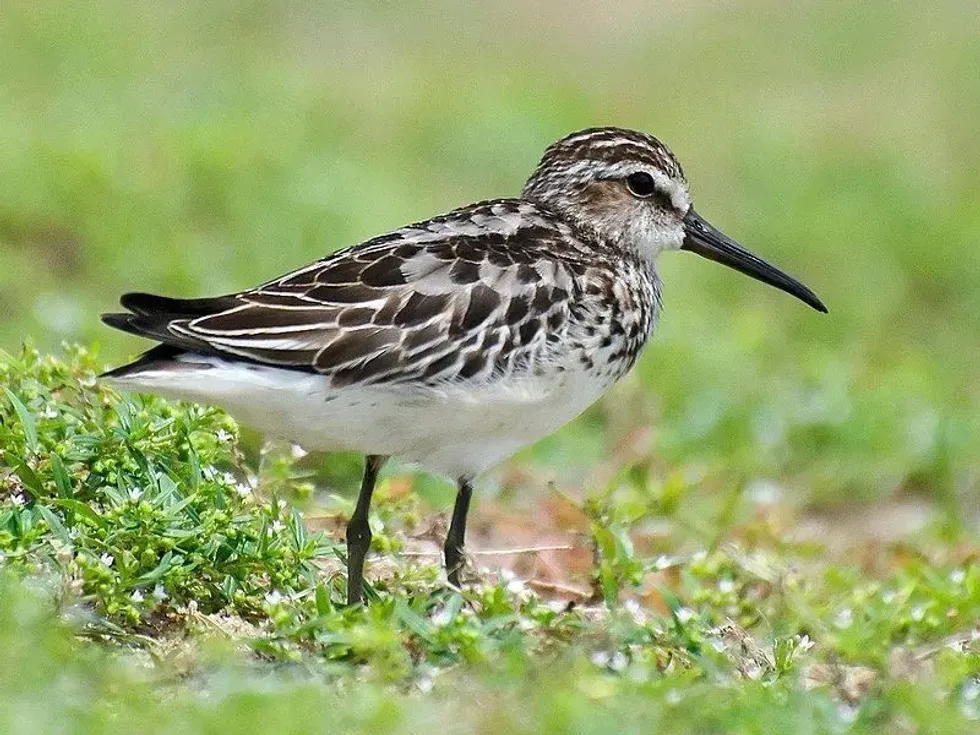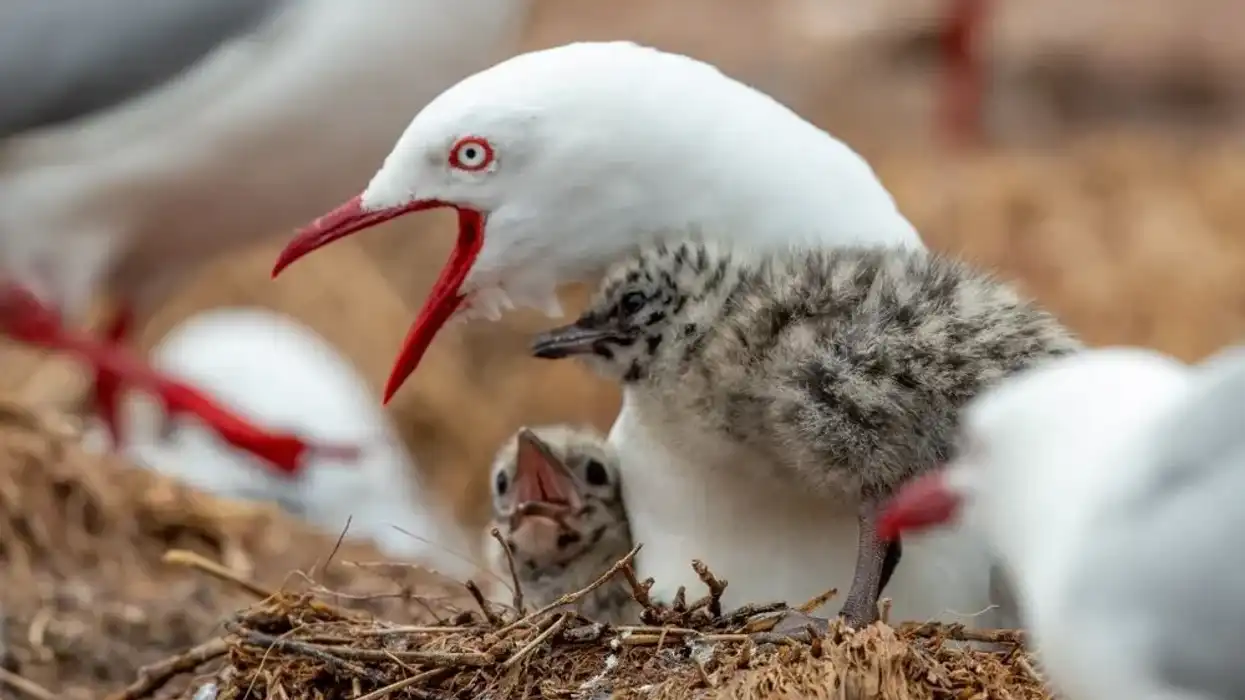The broad-billed sandpiper (Calidris falcinellus) is from the family Scolopacidae. The distribution of the population of these birds is based on the breeding and non-breeding season.
During the winter season, it is found in eastern Africa, south-east and South Australia, and the Asia range. The breeding season is spent in Arctic northern Siberia and the European range.
The habitat of these birds consists of open and large wet bogs in lowlands wet regions and subarctic montanes. When migrating, this bird is known to be spotted in soft muddy areas, near ponds and lakes in inland wetlands.
The breeding plumage of this bird consists of dark brown upper parts with white lines on the edges of the mantle and scapulars. The bill of this bird is also black in color with a yellowish tinge at the base.
The bill is long and curved downwards. The winter plumage of this species has dull gray-brownish crown feathers and also the upperparts and white underparts. The young one looks similar to the breeding adult.
The food consists of crustaceans like crabs, mollusks like shellfish, and worms. The flight speed of this bird is not known. Two subspecies of this bird have been recognized, one that breeds in Russia and Scandinavia and the other one breeds in Siberia. This bird is named so because of its whistled calls.
It is very fascinating to discover about this bird and if you like, read about white-rumped sandpiper and stilt sandpiper, too.
Broad-Billed Sandpiper Interesting Facts
What type of animal is a broad-billed sandpiper?
The broad-billed sandpiper is a type of bird.
What class of animal does a broad-billed sandpiper belong to?
It is categorized under the class of Aves.
How many broad-billed sandpipers are there in the world?
There is no estimation available for the global population of this bird.
Where does a broad-billed sandpiper live?
The population of this bird is migratory and the distribution of the population of this bird during the non-breeding season is in eastern Africa, south-east and South Australia, and the Asia range. The breeding season is spent in Arctic northern Siberia and northern Europe. This bird is not endemic to a place.
What is a broad-billed sandpiper's habitat?
The breeding habitat consists of open and large wet bogs in lowlands wet regions and subarctic montanes. When migrating for the winter season, this bird is known to be spotted in soft muddy areas, near ponds and lakes in inland wetlands.
This bird can also be found in overgrazed meadows, ricefields - even the flooded ones, and shallow and saline freshwater.
Who does broad-billed sandpiper live with?
During the time of migration, these birds can be seen in groups. These birds form flocks of 10 or less than 10 birds which is quite different from other wader species as they tend to forms groups of around 100 birds.
These birds are known to have a gregarious behavior and tend to form flocks with wader species like dunlins.
How long does a broad-billed sandpiper live?
The lifespan of this bird is around six years.
How do they reproduce?
The breeding season of this species in the northern hemisphere occurs in June and August. The mating habitat consists of open and wet bogs.
The breeding takes place in subarctic montanes in wet bogs. To attract females, the males tend to engage in aerial displays. The males tend to build many nests and a single one is selected by a female.
The nest is a scrape in the ground and three to four eggs are laid. It has been observed that the incubation and care of the chicks are shared by both males and females.
What is their conservation status?
These birds are classified as Least Concern for their conservation status. The Agreement on the Conservation of African-Eurasian Migratory Waterbirds (AEWA) applies to this bird species.
Broad-Billed Sandpiper Fun Facts
What does broad-billed sandpiper look like?
The breeding plumage of this species has dark brown colored upperparts with white lines at the tip of the mantle and scapulars which are black in color. The wing coverts of the upper wing are brown-gray with white edges.
The breast is washed version of brown and has some blackish streaks. These streaks tend to contrast with the belly as it is white in color.
The flanks are also striped but slightly with dark brown color. The crown of this species is blackish and also has a black eyestripe.
The bill of this bird is also black in color with a yellowish tinge at the base. The bill is long and curved downwards. The eyes of this bird are dark brown in color and legs and feet have a green, brown, or yellowish tinge.
The non-breeding adult plumage has dull gray-brownish crown feathers and also the upperparts, whereas, the underparts are white with the breast having brownish-gray streaks. The juvenile of this species appears like the breeding adult but has a whitish or chestnut-colored tip of the scapulars, mantles, and tertials and the breast has slightly buff streaks.
Females are slightly bigger than males. To easily spot this bird, look at the bill.

How cute are they?
These birds are not considered cute.
How do they communicate?
Communication takes place through different types of sounds and calls produced. The call for the contact of the broad-billed sandpipers is considered to be dry whistling and can be explained as 'dik dik' or 'dree-it dree-it'.
How big is a broad-billed sandpiper?
The length of this species ranges from 6.3-7 in (16-18 cm). It is known to be slightly smaller than a red phalarope and also smaller than a short-billed dowitcher.
How fast can a broad-billed sandpiper fly?
The speed of flight of this species is not known.
How much does a broad-billed sandpiper weigh?
The weight of this bird is around 0.98-2.39 oz (28-68 g).
What are the male and female names of the species?
Males and females of this species do not have any specific names.
What would you call a baby broad-billed sandpiper?
Baby birds are in general referred to as chicks but there is no particular name for a baby of this species.
What do they eat?
The food of this bird consists of crustaceans like crabs, mollusks like shellfish, and worms. It also feeds on seeds and insects and tends to feed during wading.
Are they dangerous?
These birds are not considered dangerous.
Would they make a good pet?
Not a lot is known about this bird as a pet, but it is believed that it is not an ideal pet as this bird is migratory.
Did you know...
The scientific name of this species, Calidris falcinellus, is derived from 'falx' or 'falcis', which means, a sickle. It is also sometimes scientifically referred to as Limicola falcinellus.
It is believed that some researchers state that this species should be placed under the genus Philomachus.
These birds can often be confused with their family members, the sharp-tailed sandpiper, or the red-necked stint.
Two subspecies of these birds are recognized, one breeding in Russia and Scandinavia and the other one breeds in Siberia.
As these birds tend to feed during wading, it is believed that they have to submerge their heads and necks in the deep water to properly searching for food in the mud.
A group of sandpipers can be referred to as fling, hill, time-step, contradiction, or a bind of sandpipers.
What are sandpipers known for?
Sandpipers are known for their long legs and bodies. The wings are known to be narrow and the bill of most species is quite narrow, too. As sandpipers are ground feeders, they are known to feed by continuously pecking in the wet mud looking for worms and insects.
How did the sandpiper get its name?
The sandpiper gets its name due to its voice as its song is short and piped and they have whistled calls.
Here at Kidadl, we have carefully created lots of interesting family-friendly animal facts for everyone to discover! Learn more about some other birds from our rufous hummingbird fun facts and guinea fowl facts pages.
You can even occupy yourself at home by coloring in one of our free printable boho birds coloring pages.










